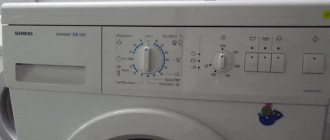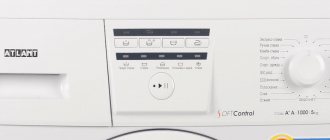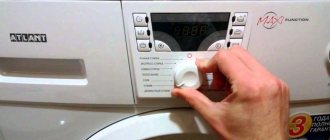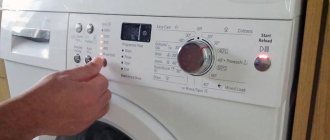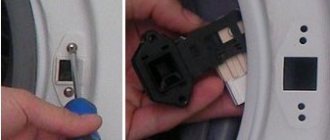Modern technology provides a system for blocking functions and stopping the active work process in the event of failure of a part or an entire mechanism. Washing machines manufactured after 2000 have a certain indication of possible breakdown. In Indesit models with electronic control, error codes for an automatic washing machine are displayed. Depending on the modification, each device has its own classification and order of fault display.
How is the problem defined?
Considering the year of manufacture and model range, the machine may signal differently about the problem of starting or completing a full wash cycle. In Indesit this can be a combination of continuously flashing buttons. If the program fails, the indicator on the panel may periodically light up red and flash a number of times equal to the code digit. In new generation technology, the display will display a direct error code that characterizes a particular breakdown.
As a rule, technical documentation describes all the characteristics of possible errors and recommendations for further actions.
The most rare reasons why a car blinks
If Indesit does not turn on, then it is worth considering even rare causes that could lead to failure. You need to pay special attention to them, because many people ignore them, and, as a result, cannot figure out the machine on their own.
It is important to accurately determine the breakdown. Be sure to check the following points:
- Involuntary drainage of water, which leads to breakdown.
- Electric motor failure. This is a fairly serious breakdown, so you can’t do it without a repairman.
- Burnout of heating element.
- Drain pump malfunction.
Let us note once again that if the washing machine does not work, the indicators will definitely flash accordingly. That is why there is no need to guess, just look at the indicators.
It is important to note that the heating element can become covered with scale over the years. That is why its wear increases significantly. The electric motor can break down due to the fact that the condition of the brushes deteriorates significantly. Fur and hair could also become tangled, which is especially common in apartments where animals live. In this case, the control module may become less likely to leave its normal state. Burnt contacts can lead to this, and this situation is quite rare.
Be sure to follow the Indesit instructions when checking error codes. The most important thing is to accurately diagnose the breakdown, so that you can then fully carry out repair work. If the cause is not correctly identified, significant amounts of money may be required to eliminate the problem. It’s better to do everything right right away so that you don’t have to worry about the problem later.
How to determine the error code in a washing machine without a display
If, after starting the program, the indication begins to blink, this indicates a malfunction of the equipment. The problem can appear at any stage: spinning, rinsing or drying. To understand exactly what problem the signals indicate, you need to decipher them.
The location of the sensors depends on the series. We look at the LEDs, check the table and find out the specific error code.
Series IWSB, IWUB, IWDC, IWSC
Here, the LEDs above the mode buttons, as well as the automatic locking sensor, are responsible for visualizing errors. The power key indicator will blink in any case if problems occur.
Location of indicators IWSB, IWUB, IWDC, IWSC
Series WISL, WIUL, WIDL, WIL, WITP
Error indicators in these series are LEDs for additional functionality (indicators 1-4) and the spin button (indicator 5). In the event of any malfunction, the lock button will blink red intensely.
Series W, WS, WT, WI
One of the oldest generations of washing machines is equipped with only two LED indicators - locking the hatch and turning on the device. Blinking with a break of 3-5 seconds indicates an error, and the number of blinks indicates its code. The sunroof lock LED usually just lights up green or red.
It should be clarified that not every washing machine malfunction is visualized in this way. If the problem is in electronic circuits or burnt-out elements, then the main panel may not light up at all.
Call the master
Even if you managed to decipher the error yourself, it is not always possible to eliminate it on your own. Lack of experience in repairing household appliances or a serious breakdown is a reason to contact a specialist. The cost of repairs depends on what exactly is broken in the equipment.
Approximate prices for some types of work:
- F02 - engine repair or replacement will cost 2,000 rubles;
- F05 - replacing the drain pump costs from 1,600 rubles;
- F08 - replacing the heating element will cost at least 1,400 rubles;
- F07 - replacing the pressure switch will cost 1,600 rubles;
- F17 - replacing the UBL costs about 1,300 rubles.
Finding a washing machine repairman is not difficult. The market is full of such offers. There are many advertisements on the Internet and in the print press in which specialists offer their services. You can also contact a specialized center.
To minimize the risk of encountering scammers, you need to pay for the service only upon its provision . Before calling a specialist to your home, you need to find out how much it will cost. Most often, technicians do not charge money for diagnostics if the client agrees to repairs.
The maximum cost of a paid call should not exceed 400 rubles. It’s good if the selected specialist has positive reviews from other clients, not on the service’s website, but on other sites.
Decoding codes
The codes will indicate the specific cause of the problem. Some problems can be solved on your own, for example, by changing the heating element or some kind of sensor. While others will require the participation of a specialist.
F01 – Engine failure
If the device refuses to start, then it is worth checking the cable with the socket for damage, as well as the network voltage (>200 V). Sometimes rebooting the equipment helps: turn off the power, wait about 15 minutes and turn it on again.
F02 – Incorrect engine operation
In this case, the centrifuge of the device does not spin, and the machine cannot start any mode. To troubleshoot the problem, check the motor carbon brushes and the voltage at the sensor (around 0.2 V). Sometimes rebooting the equipment helps.
F03 – Temperature sensor
The device stops heating water or refuses to start the selected mode. First of all, we check the sensor with a multimeter: the resistance should be about 20 kOhm. You can also try restarting the machine, turning on the rinse mode, and if it works, then ringing the heating element.
F04 – Differential pressure gauge
A malfunction of the sensor is indicated by the equipment’s refusal to start modes: water does not flow or comes in insufficient volume. It is necessary to check whether the fluid supply valve to the system is open, and also inspect the filter. Due to hard water and foreign impurities, the latter very often becomes clogged.
F05 – Drain pump
The device does not spin or rinse things, and the water does not drain. You need to check the drain valve. If the impeller rotates too freely, the element must be replaced. A clogged drain can also cause poor drainage.
F06 – Control Interface Error
The control panel stops responding to user actions. Check the power cord and socket for physical damage. We turn off the power to the equipment for 15 minutes and turn it on again. We disassemble the panel and test the contacts with a multimeter.
F07 – No signal from differential pressure gauge
After filling the tank with water, the sensor does not send a signal to the processor, and the wash does not start. To begin with, it is worth checking the water pressure in the main: the indicator should be > 1 atmosphere. Next, we inspect the tap and filter.
F08 – Heating element
Clear signs of a faulty heating element are that the water does not heat up and the wash does not finish. We test the heating element with a multimeter along with a temperature sensor. We also check the pressure gauge and the presence of blockages in the system.
Checking the heating element with a multimeter
F09 – Main module
The device stops responding to key presses. It is necessary to check the voltage in the network and reboot the equipment. There may be a software failure, which can be resolved by flashing the memory.
F10 – Low water pressure in the system
After starting work, the “Empty tank” indicator remains lit. We check the water supply tap: it must be completely open. We clean the filter from foreign debris. Sometimes rebooting the equipment or flashing the control module helps.
F11 – No voltage on the drain pump
In a good half of cases it is a burnt out pump. The device does not spin and stops draining water. In addition to the pump, it is worth checking the filters for blockages. If this is a software failure, restarting the washing machine will help.
F12 – There is no communication between the interface and the control module
The selected mode does not start, and the panel does not respond to button presses. You should check the LED contacts for open circuits. Reboot the main module: hold down the two keys ON and START for several seconds.
F13 – Drying sensor
The device does not dry things after washing. The element may have burned out, or a software glitch has occurred. We call the part and change it if necessary. If there is a failure, we try to reboot the equipment.
How does tumble dryer work?
F14 – Drying heating element does not work
For machines without drying, the problem may be in the control module (F09). After completing the program, things remain damp. We call the heating element, eliminate faults in the wiring or replace the heating element with a new one.
F15 – Drying heating element relay
On machines without this mode, the LEDs indicate a main board fault (F09). The device does not dry clothes. We call it a tandem heating element + relay and, if necessary, we change the wiring or entire elements.
F16 – Centrifuge blocked
The problem is relevant for machines with vertical feed. On front models, the code indicates problems with the main module (F09). We manually check the rotation of the drum and remove the wedge. Failure of the hatch locking mechanism can also cause the centrifuge to jam.
F17 – Hatch lock
The door does not lock and the modes do not start. We check the power: it should not be lower than 200 V. A foreign object could have gotten into the groove for the tongue or the hatch cuff might have been pinched.
F18 – Main module processor
The equipment does not respond to key presses or does not turn on at all. We try to reboot the device. If this does not help, then the control board must be replaced with a new one.
Washing machine control module
Troubleshooting and troubleshooting
If you are well versed in technology, then you can figure out all the problems yourself. You can check the condition of the electronic board and fix breakdowns at home, but first you will have to disassemble the unit.
To do this you need to do the following:
- de-energize equipment;
- remove the housing cover;
- unscrew the hex screws holding the control board;
- disconnect all wires from the connectors;
- change the capacitors (or the board itself).
In front-loading Indesit models, the electronic board is located at the bottom of the rear. Getting to it won’t be difficult if you have the most common tools. For diagnostics, it is better to use a multimeter, which can be used to “ring” capacitors and contacts.
Unwinding the case usually does not cause problems, but each model has its own design features. The control panel is mounted with two bolts at the back, and the electronic board is held in place with small screws.
Top-loading models have the electronic control panel at the top, while front-loading models have it at the lower rear.
When externally examining the electronic board, look for capacitors that have a round shape. Particular attention is paid to capacitors C16, C17 (capacitance from 680 mF to 1000 mF), C20. If they fail, they usually start to swell at the top. To accurately diagnose a breakdown, you can “ring” them with a multimeter. When replacing capacitors, you must carefully check the markings to select the exact model for your washing machine.
Other reasons for program crashes and blinking indicators
The LEDs on the control panel may blink not only due to a breakdown, but also due to incorrectly set parameters. There are a number of washing modes that provide the ability to connect additional functions:
- additional rinse
- higher degree of water heating,
- ironing
Instead of turning on, the indicator may flash if the selected program cycle does not provide a particular function.
The machine can generate a service error both at the initial stage of washing and during it. In cases where the weight of the load of laundry is not comparable to the number of revolutions or the maximum allowable volume of laundry provided for by the technical specifications, the spin process may not start. In this case, the buttons indicating a failure in the “Rinse” and “Spin” modes and the door lock indicator will start flashing. At this moment, it is necessary to restart the machine a second time, reducing the number of things.
To be able to restart or change the program mode, simply press and hold the start button.
After this, the execution of the specified program will stop. After a few seconds, the door will unlock, allowing you to make adjustments and start washing.
Indicators do not light up, machine does not work
If the washing machine does not turn on, the indicators do not light up or blink, check to see if the electricity supply in the room has been cut off. Also, if the functions do not work and the lights do not light up when turned on, check:
- Power cord. It may have been damaged or choked.
- Fork. Its body could have melted, or the contacts could have come loose.
- Connect another device to the outlet to check its functionality.
Regardless of the brand of washing machine, if you have electrical problems, call a specialist. You should not fix such problems yourself.
If you notice flashing lights when you turn on your washing machine, the first thing to do is find out what the fault code means. Then you will understand whether you can fix the problem yourself or whether you will have to contact a service center.



